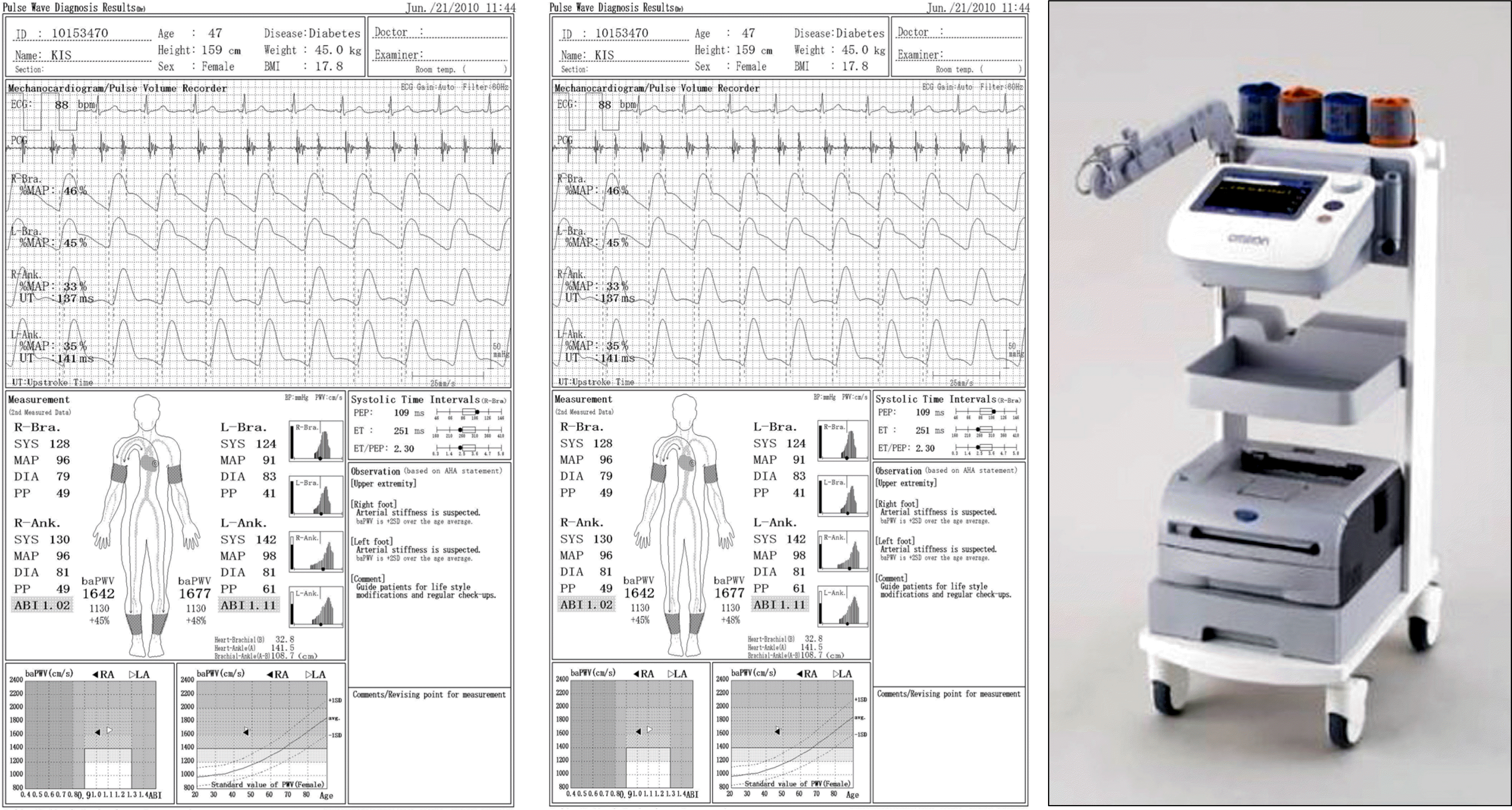Abstract
Purpose
Age-related maculopathy (ARM) is a major cause of blindness. For this reason, an early predictor of ARM is necessary for early detection and preventive therapy. The present study investigated arterial stiffness and stenosis using ankle brachial index (ABI) and pulse wave velocity (PWV) and analyzed whether arterial stiffness was affected by the extent of ARM.
Methods
A total of 257 randomized patients were enrolled in the present study. All participants underwent baPWV, ABI, blood pressure, total cholesterol, and triglyceride evaluation and were questioned regarding their history of smoking. The extent of ARM was expressed using Wisconsin ARM grading.
Results
Of the 257 patients, 29 were diagnosed with early ARM using Wisconsin ARM grading. The average age of the ARM group was 53 ± 6.56 years and was significantly greater than the average 45.93 ± 8.61 years in the non-ARM group. Other than ankle-brachial index, the clinical variables showed no significant differences after a refining process for age-related variables. Ankle-brachial index was significantly lower in the ARM group than it was in the non-ARM group (1.08 ± 0.052, 1.12 ± 0.051, respectively).
Conclusions
The ARM group showed significantly increased arterial stenosis. The present study provides a basis for the use of PWV in the early detection of ARM; however, longitudinal studies employing a larger population are required to determine the diagnostic and prognostic implications of PWV in ARM.
Go to : 
References
1. Fine SL, Berger JW, Maguire MG, Ho AC. Age-related macular degeneration. N Engl J Med. 2000; 342:483–92.

3. Friedman E. The role of the atherosclerotic process in the pathogenesis of age-related macular degeneration. Am J Ophthalmol. 2000; 130:656–63.

4. Pauleikhoff D, Chen JC, Chisholm IH, Bird AC. Choroidal perfusion abnormality with age-related Bruch's membrane change. Am J Ophthalmol. 1990; 109:211–7.

5. Metelitsina TI, Grunwald JE, DuPont JC, Ying GS. Effect of sys-temic hypertension on foveolar choroidal blood flow in age related macular degeneration. Br J Ophthalmol. 2006; 90:342–6.

6. Klein R, Klein BE, Marino EK, et al. Early age-related maculopathy in the cardiovascular health study. Ophthalmology. 2003; 110:25–33.

7. Moss SE, Klein R, Klein BE. Ankle-brachial index and the prevalence of age-related maculopathy. Am J Ophthalmol. 2005; 140:1159–61.

8. Klein R, Klein BE, Tomany SC, Cruickshanks KJ. The association of cardiovascular disease with the long-term incidence of age-related maculopathy: the Beaver Dam Eye Study. Ophthalmology. 2003; 110:1273–80.
9. van Leeuwen R, Ikram MK, Vingerling JR, et al. Blood pressure, atherosclerosis, and the incidence of age-related maculopathy: the Rotterdam Study. Invest Ophthalmol Vis Sci. 2003; 44:3771–7.

10. Vingerling JR, Dielemans I, Bots ML, et al. Age-related macular degeneration is associated with atherosclerosis. The Rotterdam Study. Am J Epidemiol. 1995; 142:404–9.
11. Cheung N, Liao D, Islam FM, et al. Is early age-related macular degeneration related to carotid artery stiffness? The Atherosclerosis Risk in Communities Study. Br J Ophthalmol. 2007; 91:430–3.

12. Klein R, Clegg L, Cooper LS, et al. Prevalence of age-related maculopathy in the Atherosclerosis Risk in Communities Study. Arch Ophthalmol. 1999; 117:1203–10.

13. Klein R, Davis MD, Magli YL, et al. The Wisconsin age-related maculopathy grading system. Ophthalmology. 1991; 98:1128–34.

14. Zheng ZJ, Sharrett AR, Chambless LE, et al. Associations of an-kle-brachial index with clinical coronary heart disease, stroke and preclinical carotid and popliteal atherosclerosis: the Atherosclerosis Risk in Communities (ARIC) Study. Atherosclerosis. 1997; 131:115–25.

15. Rachapalli SM, Kiely PD, Bourke BE. Prevalence of abnormal ankle brachial index in patients with primary Sjogren's syndrome. Clin Rheumatol. 2009; 28:587–90.

16. Muro Y, Sugiura K, Morita Y, Tomita Y. An evaluation of the efficacy of the toe brachial index measuring vascular involvement in sys-temic sclerosis and other connective tissue diseases. Clin Exp Rheumatol. 2009; 27:26–31.
17. van Popele NM, Grobbee DE, Bots ML, et al. Association between arterial stiffness and atherosclerosis: the Rotterdam Study. Stroke. 2001; 32:454–60.
Go to : 
 | Figure 1.Pulse wave analyzer and report of the result. Brachial-ankle pulse wave velocity was measured with a volume-plethysmo-graphic apparatus (automatic waveform analyzer: VP-1000, Colin Co, Komaki, Japan). This instrument simultaneously records the brachial-ankle pulse wave velocity, brachial-ankle pressure index, electrocardiogram and heart sound. |
 | Figure 2.Ankle-brachial index (ABI) measurement. ABI < 0.5: severe peripheral arterial occlusive disease (PAOD); 0.5 < ABI <0.9: mild to moderate PAOD; 0.9 < ABI < 1.3: normal; ABIb > 1.3: non compressible (medial sclerosis, calcification). |
Table 1.
Baseline clinical characteristics of the study cohort
Table 2.
Clinical characteristics of the study after controlling of age factor




 PDF
PDF ePub
ePub Citation
Citation Print
Print


 XML Download
XML Download